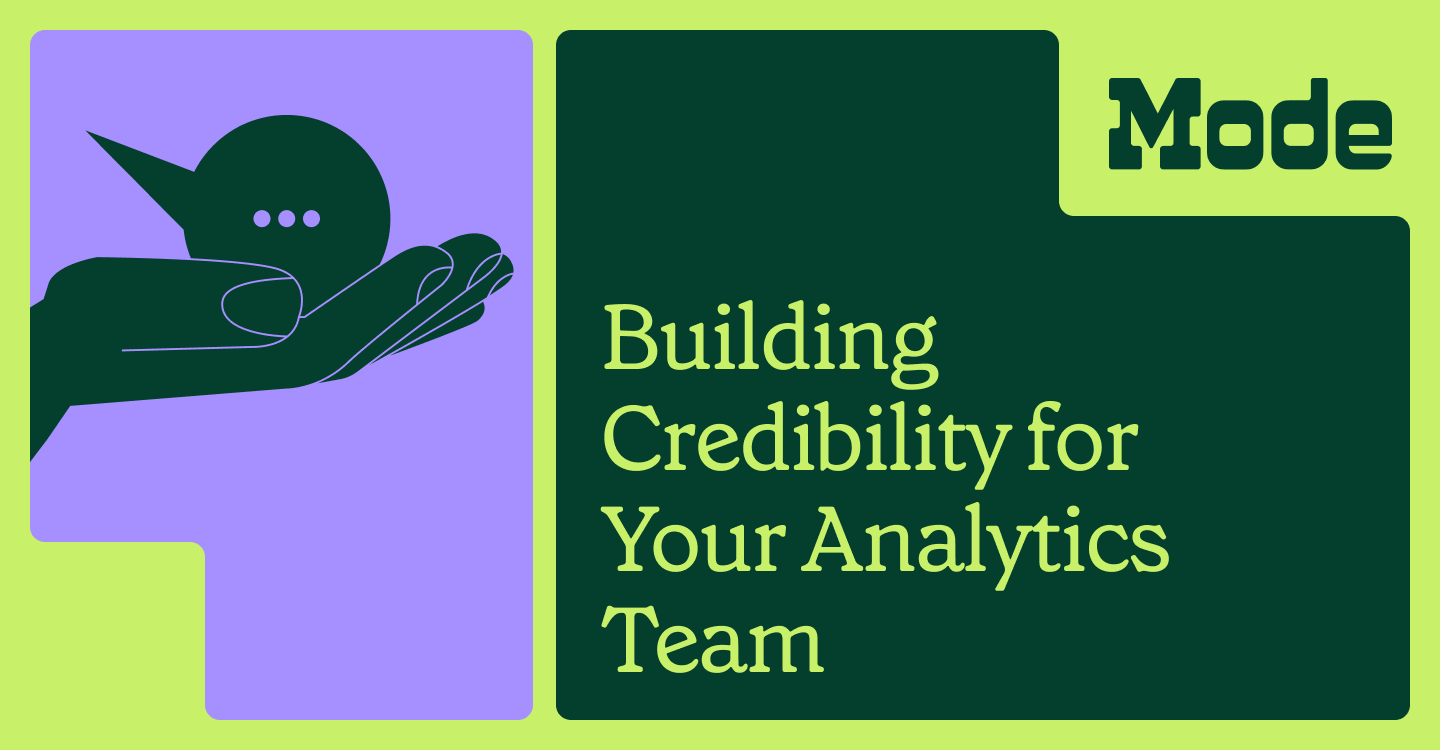Building Credibility for Your Analytics Team—and Why It Matters

Derek Steer, Co-founder & Chief Strategy Officer
January 21, 2015
NaN minute read

Building a successful analytics team requires investment in everything from people and tools to infrastructure and event tracking. But the biggest payoffs can often come from investing in credibility.
If you work with data regularly, chances are you trust it. You know how it's collected and stored. You know the caveats and the roadblocks you face when analyzing it. But, when you bring your findings to those further removed, you're asking them to take a leap of faith and trust data they may know very little about.
The best way to ease this leap of faith is to establish credibility for your team, tools, and process. Analytics teams are most effective when their work identifies incorrect assumptions or intuitions, and highlights decisions that can make the business better. But if your team has no credibility, peers will be skeptical of findings, ignore recommendations, and revert to decisions based on intuition alone—which can be a losing outcome for everyone.
Here are a few ways to build credibility for your analytics team—and ensure you keep it.
Start small
If you make early mistakes in any professional endeavor, it's incredibly difficult to establish credibility later—your managers and peers will remember your errors and question your better work. Conversely, if you establish yourself as credible from the beginning, future errors will be approached with a mindset of “even smart people make mistakes.”
When trying to get people to believe in your team, it can be tempting to chase the biggest problems first. These problems often take a long time to answer and can take several tries to get right. It's often better to first establish trust by picking early projects that you know you can win, and win quickly. Try starting with basic arithmetic to answer crucial business and product questions. For startups, some example questions might be:
What are the most engaging features of your product?
What is the company's core demographic? What do they like about the product?
Often, people don’t judge the answers to these questions on technical rigor, they judge them on business impact. Starting small can open doors to the big questions that you may have wanted to start with; if you've earned credibility along the way, you'll have more time, flexibility—and possibly resources—to tackle them.
Takeaway: Early mistakes can be deadly. Start simple, win often, and build towards more challenging problems.
Know your audience
If your goal is to drive decisions, then it's important to make decision-makers comfortable.
While there are always exceptions, I've found some audiences to have pretty consistent preferences: Executives are usually looking for simplicity and clear implications of decisions. Many non-technical folks want simple numbers that explain trends they're seeing. Engineers often want detail and want to know that you're data literate.
Keep your audience in mind as you begin to craft the story from your data. Add in the appropriate amount of detail your audience needs to focus on decisions rather than methods. What context might they need? Spending a little time thinking about what your audience cares about can help you anticipate possible questions and prepare answers in advance. Few things can help establish credibility faster than fielding a question during a presentation and immediately flipping to a slide that answers it.
Takeaway: Effective analysis is as much about communication as it is about data. Communicate in a way that connect with your audience.
Don’t be a House
House, a brilliant albeit fictional doctor, routinely diagnosed rare diseases but had abysmal bedside manner. The thing was, House didn’t have to win his patients over—they were so desperate to survive that they would listen to his every word.
Your customers (internal stakeholders) won’t die without you. They may even feel like they don’t actually need your help or data to do their jobs. In a way, they're already working with their own data points: past wins and losses.
To analysts, data often feels objective and rational. To others, it can be intimidating and confrontational. Data-driven recommendations can come across as an allegation of poor work, especially if the data challenges decisions that have already been made. Ironically, it is these sorts of situations—the ones which require the most trust—in which data analysis can be most valuable.
It's subtle, but consider your findings a conversation starter. Understand that the non-analysts have valid points too: they have experiences you don't have and they likely know something you don't. These discussions aren't about winning an argument, but making the right decision for the business.
Takeaway: Your data is a conversation starter, not a diagnosis.
Be transparent
Picture this: you're using a product that lets you input some information to get back a recommendation. This “black box” produces results that run counter to your expectations. Your instinct might be to say “the algorithm must be wrong.” After all, you know your own thought process intimately and believe it to be right. Since you can't recreate the algorithm, it’s easier to write it off as wrong.
Analytics can feel like a black box to many people and can make the leap of faith appear even larger. By showing even just the basics of your process, you can help others believe in it. To increase transparency try:
Making your work simple and understandable. Monica Rogatti would urge you to try division before doing anything harder. As your audience becomes more comfortable, up the game to simple regression models; it's not usually difficult for folks to understand the direction and magnitude of coefficients.
Finding simple ways to convey advanced concepts. For example, confidence intervals and p-values can be confusing for many people, but charts with error bars make these concepts easy to understand.
Using stories. If you're presenting information about feature usage, or events with technical backend names, paint a picture of how a user would see these features, or put events in plain-English names.
Transparency also has some beneficial side effects:
It's the best incentive there is to deliver great work. If you know that your work is visible and will be under scrutiny, you’ll make sure it’s really good.
Incorporating others into your thought process can spur you to look at your own work in a different light or help find the missing piece of a puzzle you've been trying to solve.
Takeaway: Show, don't tell, how you go to your answers in ways everyone can understand.
Everyone does it differently
As I mentioned above, credibility is tough to build and easy to lose. These strategies have worked for me and other analysts I've worked with in the past, but everyone's approach is slightly different.
How have you worked to establish credibility for you or your team? I'd love to hear stories of how you built credibility for data and analysis at your company.
Get our weekly data newsletter
Work-related distractions for data enthusiasts.




